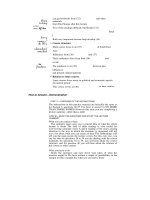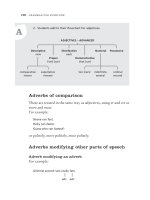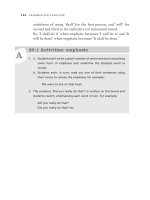Tài liệu Grammar for everyone part 5 ppt
Bạn đang xem bản rút gọn của tài liệu. Xem và tải ngay bản đầy đủ của tài liệu tại đây (99.82 KB, 7 trang )
18
G r A M M A r f o r e V e rYone
Handouts
Use handouts with discretion. Ask yourself whether they will
really have a learning outcome or are they just providing ‘busy’
work. They can be useful additions to student information,
providing examples, summaries and reference material, but for
maximum learning, discussion activities and constructing their
own sentences and charts is important.
The end product of instruction should be greater knowledge
and increased skill. For example, in teaching about adjectives the
students need skill in using adjectives effectively in their own
creative sentences. Circling words and filling in blanks provides
little opportunity for the development of the imagination or
improvement in writing expression – which should be the end
product of successful teaching.
II
The parts
of speech
Part II
This page intentionally left blank
Introduction
It is easy to assume that secondary school students would already
know what a noun is. But when the time comes to build on that
knowledge, for example to investigate noun forms such as noun
phrases and clauses and their role in the sentence, we realise that
the foundation we are about to build on may itself be shaky.
Make sure to give a definition with a full explanation for each
part of speech. Then follow with reinforcement activities geared
to the level of the students. Practice exercises will reveal any defi-
ciencies in their understanding.
Common and proper nouns are easy to understand by even
the youngest students. Collective and abstract nouns, being less
obvious, may be left a little longer or until they figure incidentally
during teaching. By practising these terms, students are also
enabled to increase their vocabulary and gain confidence from the
ability to spell.
For each category about to be learnt, students should firstly be
given, according to their age and learning level:
• a definition of the term, with discussion
• examples, preferably written on the board
The students, themselves, should then be able to:
• give the definition, i.e. correctly answer the question ‘What is a
…?’
• give examples (or word groups) in that category
• recognise examples in a sentence or list of words
• use each one correctly in a sentence
Older students may also learn the origins of the words, as given in
the following definitions, or in a dictionary.
…
21
A
Nouns
Nouns mean every thing to us!
Definition: The word ‘noun’ comes from Latin nomen meaning
‘name’. A noun is the name of a thing. Everything that exists has
a name, whether you can see it or not. A blind person cannot see
something, but that does not mean that it isn’t there! It may only
exist in our minds, like hope, beauty or calories.
There are four kinds of nouns.
Common nouns
These are names of everyday things that we can see, hear or touch.
For example:
table, banana, volcano, song
We can put the word ‘the’ in front of them and make sense, as in:
the rope, the poison
If it does not make sense, the word cannot be a noun.
1.1 Activities: common nouns
Students could do the following:
1. Walk outside, touch and name things as they pass. This is especially
popular with young children.
2. Walk outside. Come back in and name the things that they saw.
In class, the children can take turns to name one thing without
repeating any.
1
22
C
3. As above, then write down the things that they saw. Read the list
aloud. Write the words on the board.
4. Using pictures of indoor or outdoor scenes provided, students name
or list the objects they see in their picture. This activity is particularly
popular with ESL students of any age.
5. Make sentences using some of the selected words, underlining each
noun.
6. Play any form of the ever-popular parlour game ‘The Old Oak Chest’,
in which students in turn name items found in the Old Oak Chest,
each person repeating the list in its correct order and adding one
item of their own. This game can be played in a variety of ways,
such as naming articles bought at the market, or found under the
Christmas tree.
7. List things beginning with letters in alphabetical order.
For their own reference, students should write a heading NOUNS in
their grammar exercise books, followed by an accurate definition and
several examples.
Checklist: common nouns
Students should now be able to:
• correctly answer the question ‘What is a noun?’
• say one way to be sure that a word is a noun
• give examples of common nouns
• recognise nouns in sentences
• use each noun in a sentence
Proper nouns
Definition: The word ‘proper’ comes from the French word propre
meaning one’s own, i.e. belonging to a particular person or thing.
Proper nouns are the special names that we give to people,
places and particular things like the days of the week, months of
the year, or even the titles of books or TV shows.
A
23
n o u n s
A
For example:
Jason, Town Hall, China, French, The Wishing Chair
Because they are special and individual names, they start with a
capital letter and, apart from people, most of these things have
only one proper name.
1.2 Activities: proper nouns
Students could do the following:
1. Draw a large simple flowchart in their grammar exercise books. It
should have four lines, since we have four kinds of nouns. We fill in
the first two and add the remaining two later on.
Students choose their own example to add below each class head-
ing. Remember that all the proper nouns must start with a capital
letter.
2. Name the members of their family. This may be done in the form of
a family tree. For example:
3. Write answers naming, for example:
a. a friend
b. a fish
NOUNS
common
dog
breakfast
proper
Anne
India
collective abstract
Stan
(Father)
Alma
(Mother)
Julie
(sister)
Luke
(brother)
Glen
(me)
24
G r A M M A r f o r e V e rYone









